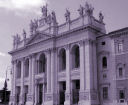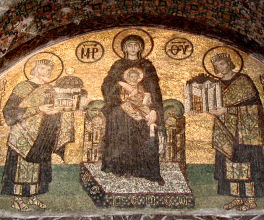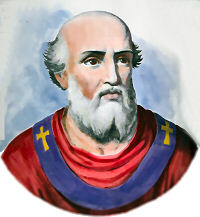Easter: May 18th
Saturday of the Seventh Week of Easter (Vigil of Pentecost); Optional Memorial of St. John I, Pope & Martyr
» Enjoy our Liturgical Seasons series of e-books!
The Church celebrates the Optional Memorial of Pope St. John I (d. 526), who was elected Pope in 523. The Arian King Theodoric sent him as his ambassador to Emperor Justin in Constantinople. On John I's return, he was captured by the king, who was displeased at the outcome of the embassy and cast him into prison at Ravenna where he died a few days later. As pope he was responsible for introducing the Alexandrian computation of the date of Easter; it came to be accepted throughout the West.
Tomorrow is the Solemnity of Pentecost, the end of the Easter season. Observance of the solemnity begins with First Vespers (Evening Prayer I) in the Liturgy of the Hours, and a special Vigil Mass before or after First Vespers. The liturgical day is from midnight to midnight in the Church's observance, except for Sunday and solemnities which begin with the evening of the preceding day.
The Pentecost Vigil liturgy has an Extended Form which echoes the Easter Vigil. There are four readings and Responsorial Psalms and prayers:
- 1st: Genesis 11:1-9 and Psalm 33(32): It was called Babel because there the Lord confused the speech of all the world.
- 2nd: Exodus 19:3-8a, 16-20b and Canticle of Daniel or Psalm 19 (18): The Lord came down upon Mount Sinai before all the people.
- 3rd: Ezekiel 37:1-14 and Psalm 107 (106): Dry bones of Israel, I will bring spirit into you, that you may come to life.
- 4th: Joel 3:1-5 and Psalm 104 (103): I will pour out my spirit upon the servants and handmaids.
>>>Today concludes the Pentecost Novena to the Holy Spirit.<<<
Meditation for Saturday of the Seventh Week of Easter:
Preparation for Pentecost: Prayer to the Father and the Son from Whom the Holy Ghost proceeds
Let us ask the Holy Ghost to enter into us and increase in us the abundance of His gifts. Fervent prayer is the condition of His indwelling in our souls. Humility is another condition. Let us come before Him with the intimate conviction of our inward poverty.
Despite our miseries, let us invoke Him; on account of these very miseries, He will hear us. Veni, Pater pauperum.
And since He is one with the Father and the Son, let us say likewise to the Father: Father, send down upon us, in the name of Thy Son Jesus, the Spirit of love that He may fill us with the intimate sense of our divine filiation. And Thou, O Jesus, our High Priest, now sitting at Thy Father's right hand, intercede for us, so that this mission of the Spirit, Whom Thou didst promise to us and didst merit for us, may be abundant; that it may be an impetuous river making glad the city of souls; or rather, according to Thine own words, "a fountain of water, springing up unto life." Hoc autem dicebat de Spiritu Sancto quem accepturi erant credentes in eum.
—Dom Columba Marmion, Christ in His Mysteries, p. 340
 The Vigil of Pentecost,
The Vigil of Pentecost, Station with San Giovanni in Laterano (St. John Lateran)
The Station is at St. John Lateran, beside the Baptistery. The night before Pentecost, like that before Easter, was at Rome, and in many other churches, a baptismal feast. Baptism was administered to those who, for one reason or another, had not received it at Easter; or to fresh candidates. Hence the resemblance between these two Virgils. It also expresses the idea of our Baptism by the Holy Spirit.
For more on San Giovanni in Laterano, see:
- Rome Art Lover
- Roman Churches
- Churches of Rome
- Aleteia
- Click here for a 360 degree virtual tour.
For further information on the Station Churches, see The Stational Church.
St. John I
This Tuscan was destined to be glorified not only during his lifetime but after his death as well. Although peace with the East had been restored, a suspicious Theodoric grumbled in his castle at Ravenna. An Arian, the king saw the new friendliness between East and West as a serious threat to his reign. To further alarm him, Emperor Justin had reinstated the laws against heretics, Arians included, and had embarked on a campaign of confiscating churches and excluding heretics from public office, causing many Arians to abandon their faith. Infuriated, Theodoric summoned John to Ravenna and ordered him to head a delegation to the orthodox emperor to ask that the persecution stop and allow forced converts to return to Arianism. At first John refused, then fearing that the king's wrath would be taken out on Western Catholics, he agreed to do Theodoric's bidding on every count save one. He boldly told the king that he would not ask the emperor to allow converts to return to heresy.
The pope arrived in Constantinople shortly before Easter in 526, and since he was the first pope to leave Italy, his reception was more than he could have dreamed. He had been met by the entire city at the twelfth milestone, where the clergy led the procession carrying candles and crosses, and even the emperor prostrated himself before the Holy Father.  The day of Easter, John was seated in a throne higher than the one occupied by the patriarch, in the church of Sancta Sophia, where he celebrated Mass in the Latin tradition. John was accorded the highest honor when he placed the customary Easter crown on the head of Emperor Justin.
The day of Easter, John was seated in a throne higher than the one occupied by the patriarch, in the church of Sancta Sophia, where he celebrated Mass in the Latin tradition. John was accorded the highest honor when he placed the customary Easter crown on the head of Emperor Justin.
After meeting with Justin on Theodoric's behalf, the pope made the exhausting trip back to Ravenna. The king's fury raged. Jealous of the pope's grand reception in the East, Theodoric accused the pope of failing his mission by not securing all of the demands put to Justin. The king then ordered John to remain in Ravenna at his disposal. The aged pope was spent; the prospects before him were dismal. Already ailing, Pope John died and was hastily buried outside the castle walls. Pope John's body was exhumed and on May 27, 526, was returned to Rome and placed in the nave of St. Peter's.
—Excerpted from The Popes: A Papal History, J.V. Bartlett
Highlights and Things to Do:
- The Church has had a long, unbroken line of popes. Have your children answer the following questions: How many popes has the Church had? How many popes are honored with the title of saint, blessed or venerable? Which pope reigned longest? Which three names have been chosen most frequently by popes? You can check this page to help get the answers.
- Pray especially for the Holy Father today. Pray a type of the Morning Offering in which we pray for the Holy Father's intentions.
- Read more about Pope St. John I:
- Pope John is buried in St. Peter's Basilica.








